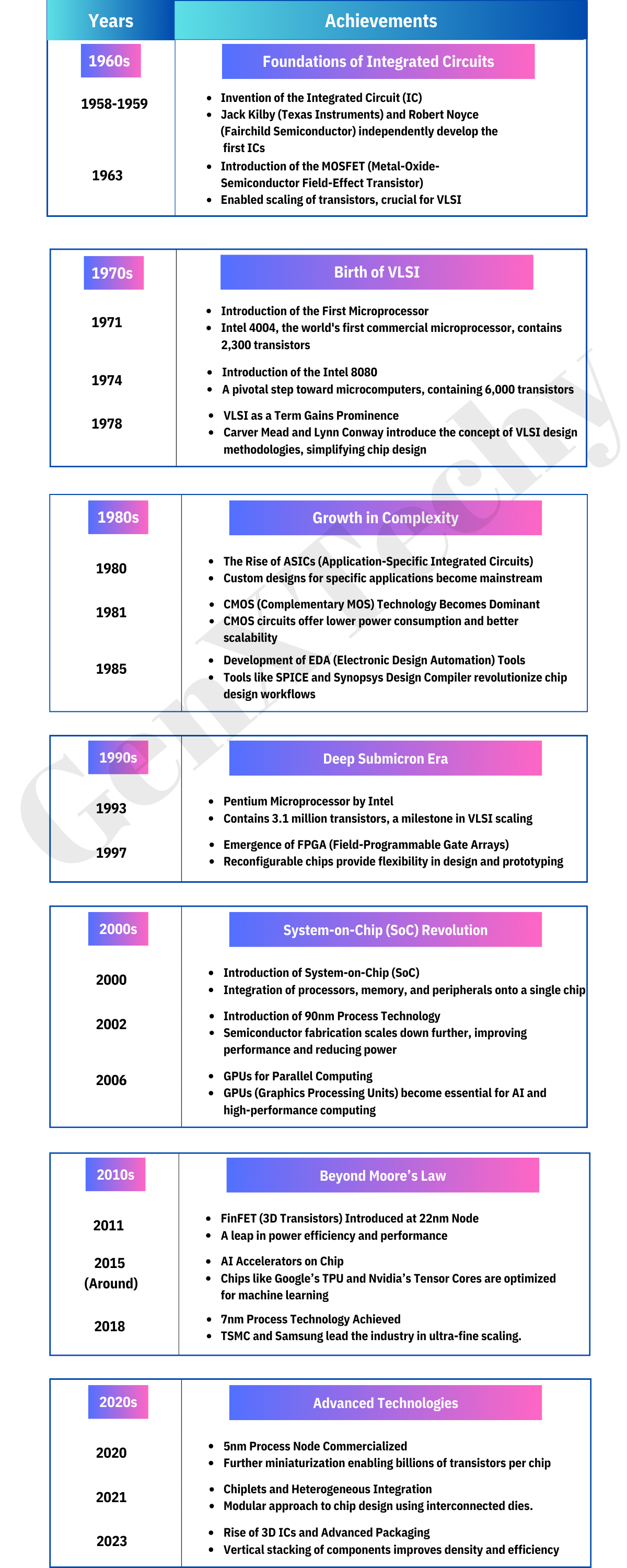Timeline of VLSI Evolution: Major Milestones

Evolution of Integration Levels in Integrated Circuits (ICs)
Depending on the level of integration of components into a single chip, the IC technology is classified into several categories. Table 2.1 shows the evolution of integration levels in integrated circuits (ICs).
Table 2.1: Integration levels in Integrated Circuits
| Integration Level | Transistor Count | Year/Time Period | Examples |
|---|---|---|---|
| Small-Scale Integration (SSI) | 10-100 transistors | 1960s | First ICs (Jack Kilby, Robert Noyce) |
| Medium-Scale Integration (MSI) | 100-1,000 transistors | Late 1960s to 1970s | Logic gates, simple processors |
| Large-Scale Integration (LSI) | 1,000-10,000 transistors | 1970s | Intel 4004 (1971), Intel 8080 (1974) |
| Very Large-Scale Integration (VLSI) | 10,000 to 1 million transistors | 1980s | Intel 80386, ASICs |
| Ultra-Large-Scale Integration (ULSI) | Over 1 million to billions of transistors | 1990s to 2000s | Pentium Microprocessors, SoC |
| System-on-Chip (SoC) | Billions of transistors on a single chip | 2000s onwards | GPUs, AI Chips, Modern Processors |
| 3D ICs and Advanced Packaging | Vertical stacking and modular integration | 2020s onwards | Advanced Packaging, 3D ICs, Chiplets |
- SSI (Small-Scale Integration): Early ICs were basic and could only handle a small number of components.
- MSI (Medium-Scale Integration): Enabled more complex logic circuits and basic processors.
- LSI (Large-Scale Integration): Revolutionized technology with microprocessors like the Intel 4004.
- VLSI (Very Large-Scale Integration): Marked the growth of modern computing, enabling systems to be integrated into a single chip.
- ULSI (Ultra Large-Scale Integration): Chips with millions and eventually billions of transistors, supporting modern computers.
- SoC (System-on-Chip): Combines processors, memory, and peripherals on a single chip.
- 3D ICs: Modern approach with vertical stacking and modular integration for higher efficiency and density.
Types of Integrated Circuit
The main goal of Integrated Circuit (IC) design and fabrication is to enhance functionality and speed while reducing power consumption, chip size, and production costs, using advanced design and manufacturing techniques.
a) Table 2.2 summarizes the types of Integrated Circuits (ICs) based on different types of substrates.
Table 2.2: ICs based on different types of substrates
| Type of Substrate | Description | Examples/Applications |
|---|---|---|
| Silicon (Si) Substrate | Most widely used substrate in IC manufacturing due to its availability, cost-effectiveness, and semiconductor behaviour. | CMOS Technology, Microprocessors, Memory ICs, ASICs. |
| Gallium Arsenide (GaAs) | Used for high-speed and high-frequency applications, with better electron mobility than silicon. | RF ICs, Microwave ICs, Optoelectronic Devices. |
| Silicon Carbide (SiC) | High-temperature, high-power, and high-frequency substrate for power electronics. | Power ICs, High-Voltage Switching Devices. |
| Gallium Nitride (GaN) | Wide-bandgap material suitable for high-power and high-frequency applications. | Power Amplifiers, RF ICs, LED Drivers. |
| Sapphire (SOS – Silicon on Sapphire) | Insulating substrate with excellent electrical isolation and radiation resistance. | Radiation-Hardened ICs, RF Circuits, Aerospace Applications. |
| Glass Substrate | Used for specific high-frequency and display applications. | LCD Displays, MEMS (Microelectromechanical Systems). |
| Germanium (Ge) | Early substrate for transistors; still used for optoelectronic applications. | Photodetectors, High-Speed Transistors. |
| Silicon-on-Insulator (SOI) | Thin silicon layer on an insulating substrate for reduced parasitic capacitance and power. | High-Performance CPUs, Low-Power ICs. |
| Polymer Substrate | Flexible and lightweight substrates for specific applications. | Flexible Electronics, Wearable Devices. |
b) Based on the devices used for implementing the ICs are classified in Table 2.3.
Table 2.3: ICs based on different types of devices
| Type of Devices | Description | Examples/Applications |
|---|---|---|
| Bipolar ICs | Bipolar ICs are based on bipolar junction transistors (BJTs), which rely on both electron and hole carriers for current conduction. These ICs excel in high-speed, high-gain, and precision analog applications, making them an essential part of many electronic systems. | Amplifiers, oscillators, and analog-to-digital converters. |
| CMOS ICs | CMOS ICs are a widely used type of integrated circuit that utilizes both p-type and n-type MOSFETs (Metal-Oxide-Semiconductor Field-Effect Transistors) to perform digital, analog, or mixed-signal operations. They are favored for their low power consumption and scalability. | Microprocessors, microcontrollers, memory chips (RAM, ROM). |
| BiCMOS ICs | BiCMOS ICs combine the advantages of Bipolar Junction Transistors (BJTs) and CMOS technology in a single integrated circuit. This hybrid approach leverages the high speed and current-driving capability of BJTs with the low power consumption and high input impedance of CMOS transistors. | Used in RF circuits, broadband amplifiers, and data converters. |
| MESFET-based ICs | MESFET-based ICs utilize Metal-Semiconductor Field-Effect Transistors (MESFETs), which are similar to JFETs (Junction FETs) but use a Schottky barrier instead of a p-n junction for the gate. These ICs are primarily used in high-frequency and high-power applications due to their excellent performance in microwave and RF domains. | Used in microwave transmitters, receivers, and RF amplifiers. |
| HBT-based ICs | Heterojunction Bipolar Transistor (HBT)-based ICs use HBTs, a specialized type of bipolar junction transistor (BJT), in their design. HBTs leverage a heterojunction instead of a homojunction, where the emitter and base are made from materials with different bandgap energies. This design enhances performance characteristics, particularly for high-speed and high-frequency applications. | Used in RF amplifiers, power amplifiers, and microwave circuits for cellular and satellite communication. |
| HEMT-based ICs utilize High Electron Mobility Transistors (HEMTs), a type of field-effect transistor (FET) that exploits a heterojunction structure to achieve high-speed and high-frequency performance. HEMTs are particularly well-suited for microwave, millimeter-wave, and RF applications due to their superior electron mobility and low noise characteristics. | Used in RF front-ends for cellular networks, satellite communication, and wireless technologies. |
